Since the beginning of the comic book industry, accusations of plagiarism, stolen ideas, and blatant rip-offs have been common. One of the oldest such cases, that between Marvel’s Man-Thing and DC’s Swamp Thing, is actually an instance of both publishers copying the same Golden Age character. Marvel and DC have been in fierce competition with one another since the 1940s, but their rivalry truly heated up in the Silver Age.The 1960s saw Marvel surpass DC as America’s number one comic book publisher, thanks to creations like X-Men, Fantastic Four and Spider-Man. The publisher has remained number one, and the decades since included many instances were both companies rolled out very similar characters — often around the same time. The best example of this was the debut of the mossy swamp monsters, Man-Thing and Swamp Thing, who appeared mere months between each other. This has become the poster child of allegations of cross-company swiping and the debate over copying ideas and plagiarism. However, the reality is that both of these monster heroes were inspired by the Golden Age character, the Heap. The Golden Age has, since the very first comic books, had a strong impact and influence on subsequent characters, especially superheroes. A great example is how Will Eisner’s Spirit helped usher in the classic fedora-wearing private detective. This directly influenced the creation of heroes like Rorschach, Mr A, Question and, arguably, even Howard the Duck. Another example of how creators unapologetically borrowed from classic comics was the incorporation of Doc Savage’s Fortress of Solitude into Superman’s lore. Putting it simply, countless creators have turned in their own spin on these Golden Age characters, some being identical in all but name. Whether fans see it as flattering imitation or unoriginal copying, it’s very much the norm for creators to rework an older character into their own works. Each generation of writers have turned to the comics they grew up reading for influence, and there’s nothing wrong with this. In fact, both Marvel and DC Comics have shown an absolute willingness to use unoriginal public domain characters, such as Dracula, Frankenstein’s Monster, Sherlock Holmes, and Jekyll & Hyde. However, when it comes to newer designs that share a common inspiration, many are too quick to defend one as “original,” often siding with their preferred publisher. This often happens with Man-Thing and Swamp Thing. Some have concluded that Marvel copied DC’s Swamp Thing, while others was positive DC copied Marvel’s Man-Thing. Neither is true. Marvel and DC actually drew inspiration from Heap in the same way George of the Jungle and Ka-Zar both copied Tarzan. Homage, imitation and, even overt copying, are fixtures of comics — and they’ve only become more common and tongue-in-cheek.RELATED: One of DC’s Oldest Heroes Just Returned in the Most Exciting Way PossibleRELATED: One of DC’s Strongest Heroes Has a Deep Dislike for the Doom Patrol
Since the beginning of the comic book industry, accusations of plagiarism, stolen ideas, and blatant rip-offs have been common. One of the oldest such cases, that between Marvel’s Man-Thing and DC’s Swamp Thing, is actually an instance of both publishers copying the same Golden Age character. Marvel and DC have been in fierce competition with one another since the 1940s, but their rivalry truly heated up in the Silver Age.
The 1960s saw Marvel surpass DC as America’s number one comic book publisher, thanks to creations like X-Men, Fantastic Four and Spider-Man. The publisher has remained number one, and the decades since included many instances were both companies rolled out very similar characters — often around the same time. The best example of this was the debut of the mossy swamp monsters, Man-Thing and Swamp Thing, who appeared mere months between each other. This has become the poster child of allegations of cross-company swiping and the debate over copying ideas and plagiarism. However, the reality is that both of these monster heroes were inspired by the Golden Age character, the Heap.
The Golden Age has, since the very first comic books, had a strong impact and influence on subsequent characters, especially superheroes. A great example is how Will Eisner’s Spirit helped usher in the classic fedora-wearing private detective. This directly influenced the creation of heroes like Rorschach, Mr A, Question and, arguably, even Howard the Duck. Another example of how creators unapologetically borrowed from classic comics was the incorporation of Doc Savage’s Fortress of Solitude into Superman’s lore. Putting it simply, countless creators have turned in their own spin on these Golden Age characters, some being identical in all but name. Whether fans see it as flattering imitation or unoriginal copying, it’s very much the norm for creators to rework an older character into their own works. Each generation of writers have turned to the comics they grew up reading for influence, and there’s nothing wrong with this. In fact, both Marvel and DC Comics have shown an absolute willingness to use unoriginal public domain characters, such as Dracula, Frankenstein’s Monster, Sherlock Holmes, and Jekyll & Hyde. However, when it comes to newer designs that share a common inspiration, many are too quick to defend one as “original,” often siding with their preferred publisher. This often happens with Man-Thing and Swamp Thing. Some have concluded that Marvel copied DC’s Swamp Thing, while others was positive DC copied Marvel’s Man-Thing. Neither is true. Marvel and DC actually drew inspiration from Heap in the same way George of the Jungle and Ka-Zar both copied Tarzan. Homage, imitation and, even overt copying, are fixtures of comics — and they’ve only become more common and tongue-in-cheek.
#ManThing #Swamp #Based #Older #Monster
Note:- (Not all news on the site expresses the point of view of the site, but we transmit this news automatically and translate it through programmatic technology on the site and not from a human editor. The content is auto-generated from a syndicated feed.))



